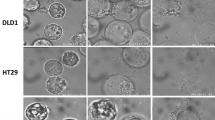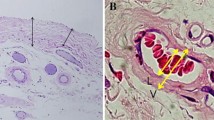Abstract
For 100 patients with gastric cancer, intraoperative intraperitoneal perfusion(IOIPP) using double - distilled water (D. D. W) with hibitane 37°C for 5 minutes was performed. The anticancer effects were assessed cytologically in pre - IOIPP and post-IOIPP specimens of the abdominal effusion and/or lavaged peritoneal fluid. The radical gastrectomy was performed in 65 of 93 cases with advanced gastric cancer, shed cancer cells in peritoneal cavity were detected in 16 of 65 cases with pre - IOIPP (24.62%) and in 3 of post - IOIPP cases (4.62%). There was significant difference between the two groups (P<0.01). Shed cancer cells were inactivatedin vivo estimated by the trypan - blue staining technique in 7 cases with radical surgery. But the effect of the IOIPP on shed cancer cells was not significant in cases with peritoneal metastasis. Also there were shed cancer cells in peritoneal cavity of patients with SS cancer histologically before the IOIPP (15.56%) and iatrogenic diffusion of cancer cells during operation (7/24) in thisarticle. The above results indicated that the IOIPP with hypo - osmolar solution containing hibitane, 37°C for 5 mm was indispensable and useful for the killing of peritoneal shed cancer cells in order to prevent postoperative peritoneal recurrence in patients with radical surgery of advanced gastric cancer regardless of conditions of serosal invasion.
Similar content being viewed by others
References
1991; 29:220.
1992; 38:1089.
Fujimoto S, Takahashi M, Kobayashi K, et al. Cytohistologic assessment of antitumor effects of intraperitoneal hyperthermic perfusion with Mitomycin C for patients with gastric cancer with peritoneal metastasis. Cancer 1992; 70:1754.
Chen Junqing, Liu Qinghua. Identification and classification of serosal invasion, as it relates to cancer cells shedding and surgical treatment in gastric cancer. Semin Surg Oncol 1994; 10:107.
Hagiwara A, Takahashi T, Kojima O, et al. Prophylaxis with carbon - adsorbed Mitomycin against peritoneal recurrence of gastric cancer. The Lancet 1992; 339:629.
1991; 13:97.
1994; 16:14.
Arázazu PM, Ostolaza H, Goñi FM, et al. Surfactant-induced cell toxicity and cell lysis—a study using B16 melanoma cells. Biochemical Pharmacology 1990; 40:1323.
1992; 14:316.
Liu Qinghua, Chen Junqing. The relationship between serosal types, pathological characteristics and free cancer cells in the peritoneal cavity of gastric cancer patients. Chinese J Cancer Res 1989; 1:58.
Author information
Authors and Affiliations
Rights and permissions
About this article
Cite this article
Dai, D., Chen, J., Yuan, Y. et al. The effect of hypo-osmolar solutions with hibitane on shed cancer cells in peritoneal cavity of patients with gastric cancer. Chin J Cancer Res 7, 148–152 (1995). https://doi.org/10.1007/BF03014413
Accepted:
Issue Date:
DOI: https://doi.org/10.1007/BF03014413




